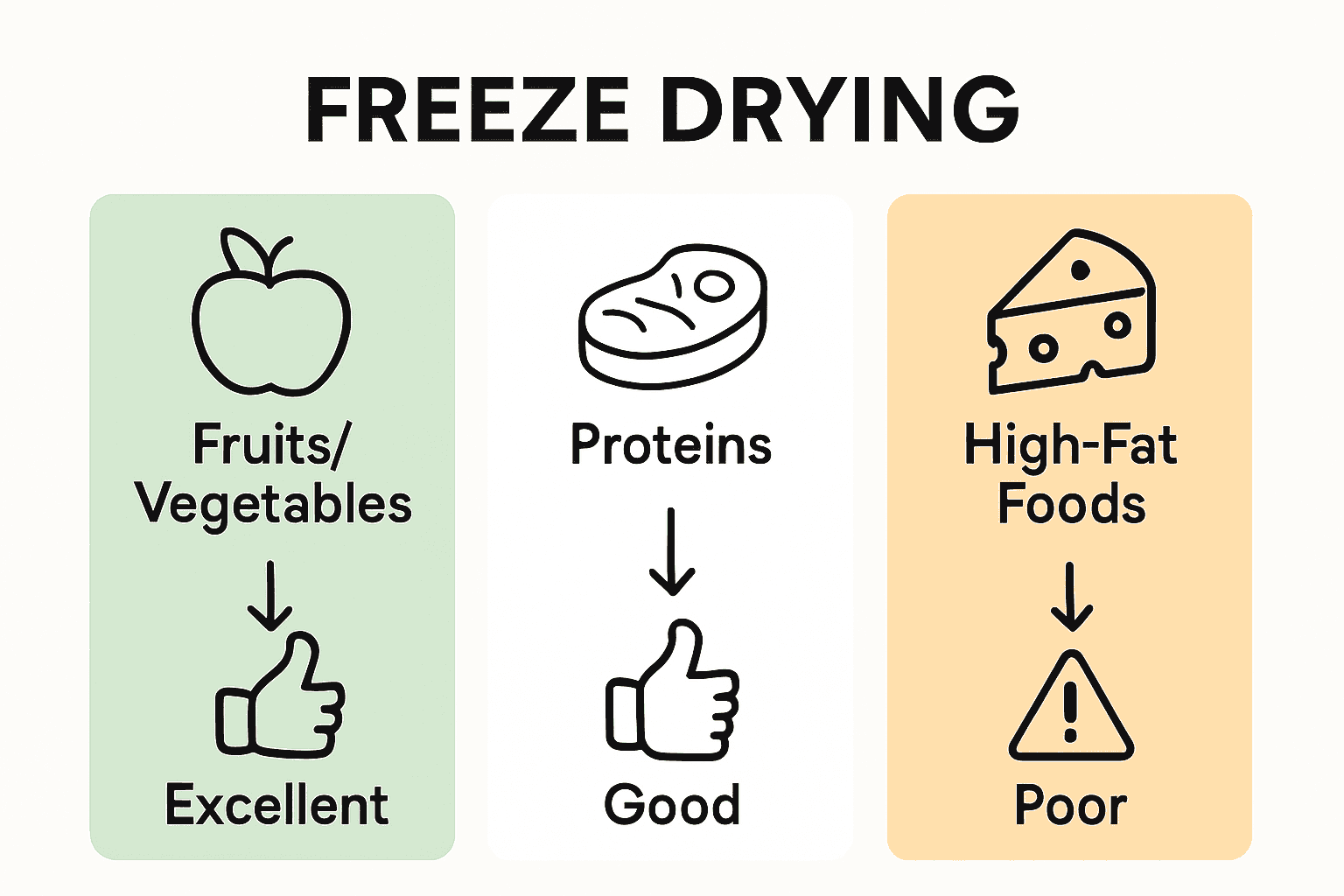Did you know that freeze drying can preserve up to 97 percent of a food’s original nutritional value? This method is changing the way people think about long-term food storage, keeping flavors and textures surprisingly close to fresh. Whether you want to cut down on waste, prepare for emergencies, or pack food for adventures, learning about freeze drying opens the door to safer, tastier, and longer-lasting ingredients.
Key Takeaways
| Point | Details |
|---|---|
| Freeze Drying Process | This method involves freezing food, followed by sublimation under low pressure, preserving its structure and nutritional content. |
| Versatility of Food Types | Most food categories can be freeze dried, but fruits, vegetables, and proteins are particularly well-suited. |
| Applications and Benefits | Freeze-dried foods are used in multiple industries, providing lightweight, shelf-stable options for space exploration, military, and outdoor activities. |
| Food Safety and Storage | Proper handling and storage are vital for safety; use moisture-proof containers and store in cool, dry places to maintain quality. |
Table of Contents
- What Is Freeze Drying Food?
- Types Of Foods Suitable For Freeze Drying
- How The Freeze Drying Process Works
- Common Applications For Freeze Dried Foods
- Critical Food Safety And Storage Factors
What Is Freeze Drying Food?
Freeze drying is a fascinating food preservation technique that transforms how we think about storing and consuming foods. According to Healthline, freeze‑drying (also called lyophilization) is a sophisticated dehydration process that maintains food’s original qualities while dramatically extending its shelf life.
The process involves three critical stages: first, the food gets completely frozen. Then, under low pressure conditions, the frozen water inside the food transitions directly from solid ice to water vapor through sublimation - skipping the typical liquid phase. This unique approach allows the food to retain its original structure, nutritional content, taste, and appearance. As research from Wikipedia indicates, this method preserves food quality by avoiding heat damage that traditional drying methods might cause.
Freeze drying offers some remarkable benefits for food preservation:
- Maintains 97% of original nutritional value
- Preserves original flavor and texture
- Extends shelf life up to 25 years
- Reduces food weight by up to 80%
- Allows easy rehydration when needed
Whether you’re a food manufacturer, outdoor enthusiast, or home cook looking to reduce food waste, read more about what foods can be freeze dried to understand the incredible potential of this preservation technique.
Types of Foods Suitable for Freeze Drying
Freeze drying is incredibly versatile, making it possible to preserve a wide range of foods with remarkable precision. According to research from the University of Minnesota Extension, most food categories can undergo this preservation technique, though some perform better than others.
Fruits and Vegetables are prime candidates for freeze drying. As Enwave highlights, popular options include:
- Berries (strawberries, blueberries, raspberries)
- Apples
- Bananas
- Peas
- Carrots
- Broccoli
- Leafy greens
Protein sources also freeze dry exceptionally well. You can preserve:
- Meats (beef, chicken, pork)
- Fish and seafood
- Eggs
- Plant-based proteins
Some foods aren’t ideal for freeze drying. High-fat items, extremely sugary foods, and certain baked goods might not maintain their structural integrity during the process. But for most whole foods, freeze drying offers an incredible way to extend shelf life while maintaining nutritional value.
IMAGE:descriptive_key_1] [Discover more about our freeze-drying capabilities and explore the potential of preserving your favorite foods.
Here’s a comparison of different food types and their suitability for freeze drying:

| Food Category | Common Examples | Freeze Drying Suitability |
|---|---|---|
| Fruits & Vegetables | Berries Apples Carrots Broccoli |
Excellent—retain flavor & nutrients |
| Meats & Proteins | Beef Chicken Eggs Seafood |
Very Good—rehydration works well |
| High-Fat Foods | Bacon Cheese Butter |
Poor—texture and stability issues |
| Sugary Foods | Candy bars Cakes Pies |
Limited—may collapse or melt |
| Leafy Greens | Spinach Kale Lettuce |
Good—lightweight, long shelf life |
How the Freeze Drying Process Works
Freeze drying is a precise and intricate food preservation method that transforms foods through a carefully controlled scientific process. According to Healthline, the technique unfolds in three critical phases that ensure maximum food quality and longevity.
The first phase involves completely freezing the food product at extremely low temperatures, typically well below zero. As explained by HowStuffWorks, the frozen items are then placed inside a specialized vacuum chamber where low pressure and gentle heat trigger an extraordinary transformation. Through a process called sublimation, the ice within the food transitions directly from solid to vapor, skipping the liquid state entirely.
The freeze drying process can be broken down into specific stages:
- Initial Freezing: Food is rapidly cooled to lock in original structure
- Primary Drying: Ice is removed via sublimation under low pressure
- Secondary Drying: Remaining bound moisture is carefully extracted
What makes this method so remarkable is its ability to preserve food’s original characteristics. By avoiding high-heat traditional drying methods, freeze drying maintains nutritional content, flavor, and structural integrity. Learn more about our specialized freeze drying techniques to understand how we transform everyday foods into long-lasting, lightweight products.
Common Applications for Freeze Dried Foods
Freeze-dried foods have revolutionized numerous industries, offering unprecedented convenience and longevity. According to Wikipedia, the food industry has embraced this technology across multiple sectors, creating innovative solutions for preserving and transporting food.
Space Exploration represents one of the most fascinating applications of freeze-dried technology. As research indicates, astronauts rely heavily on these lightweight, nutrient-dense meals during missions. The ability to create compact, long-lasting food that can be easily rehydrated makes freeze-drying crucial for space travel, where every ounce of weight matters.
Common applications of freeze-dried foods span several domains:
- Military Rations: Lightweight, long-lasting emergency food supplies
- Camping and Outdoor Gear: Portable meals for hikers and adventurers
- Culinary Ingredients: Preserving seasonal fruits and vegetables
- Instant Beverages: Producing instant coffee and other quick-mix drinks
- Emergency Food Supplies: Creating non-perishable food reserves
From professional kitchens to home pantries, freeze-dried foods offer incredible versatility. Explore our range of freeze-dried candy options to see how this technology is transforming everyday eating experiences.
Critical Food Safety and Storage Factors
Freeze drying might seem like a magical preservation method, but it’s not a guaranteed safety solution. According to the University of Minnesota Extension, freeze-drying does not automatically eliminate microorganisms. This means food safety starts long before the freeze-drying process begins.
Prior to freeze-drying, all potentially hazardous foods must be thoroughly cooked. The process reduces water activity to between 0.08–0.33, which contributes to food safety, but does not completely eliminate all risks. Proper food handling and preparation are absolutely crucial to ensure the final product’s safety and quality.
Key storage considerations for freeze-dried foods include:
- Use moisture-proof containers like Mylar bags
- Include oxygen absorbers to prevent degradation
- Store in cool, dry, and dark environments
- Maintain low-humidity storage conditions
- Keep containers sealed until ready to use
While unopened freeze-dried products can potentially last decades, maintaining proper storage conditions is critical. Learn more about our food safety protocols to understand how we ensure the highest quality and safety standards in our preservation process.
Transform Your Freeze-Dried Food Experience with Us
Are you inspired by the possibilities of freeze drying but feeling overwhelmed by food safety concerns or how to preserve the taste and quality of your favorite snacks? The Complete Guide to Foods You Can Freeze Dry makes it clear that finding a reliable partner for high-quality, long-lasting freeze-dried foods is essential. At Space Man, we specialize in turning exceptional freeze-drying knowledge into delicious reality. We offer not only premium freeze dried candy but also private labeling, custom bagging, and packaging solutions designed for food safety and consumer appeal. If you are searching for safer, tastier, and longer-lasting options for your business or personal stash, you can trust us to deliver.

Ready to explore the next level in food preservation? Visit our main site to discover our selection of freeze-dried candies, learn about how our freeze drying works, and get started now. Secure your supply of innovative, shelf-stable treats before your next adventure or product launch. Act today and taste the difference true freeze drying can make.
Frequently Asked Questions
What is freeze drying, and how does it work?
Freeze drying, or lyophilization, is a dehydration process that involves freezing food, then using low pressure to convert the frozen water directly to vapor, skipping the liquid phase. This method preserves the food’s nutritional content, flavor, and structure while extending its shelf life.
What kinds of foods are suitable for freeze drying?
Most foods can be freeze dried, but some perform better than others. Excellent options include fruits like berries and apples, vegetables such as carrots and broccoli, and proteins like meats and eggs. High-fat and very sugary items may not freeze dry well due to structural integrity issues.
How long can freeze dried foods last?
Freeze dried foods can maintain their quality and safety for an impressive duration, with some items lasting up to 25 years when stored properly in moisture-proof containers and in cool, dry environments.
Can freeze dried foods be rehydrated easily?
Yes, freeze dried foods can be rehydrated easily by adding water. The process typically restores the food’s original flavor and texture, making them convenient for meals and snacks whenever needed.

